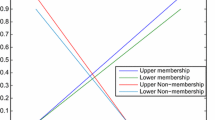Abstract
In this paper, the modified S-curve membership function methodology is used in a real life industrial problem of mix product selection. This problem occurs in the production planning management where by a decision maker plays important role in making decision in an uncertain environment. As analysts, we try to find a good enough solution for the decision maker to make a final decision. An industrial application of fuzzy linear programming (FLP) through the S-curve membership function has been investigated using a set of real life data collected from a Chocolate Manufacturing Company. The problem of fuzzy product mix selection has been defined. The objective of this paper is to find an optimal units of products with higher level of satisfaction with vagueness as a key factor. Since there are several decisions that were to be taken, a table for optimal units of products respect to vagueness and degree of satisfaction has been defined to identify the solution with higher level of units of products and with a higher degree of satisfaction. The fuzzy outcome shows that higher units of products need not lead to higher degree of satisfaction. The findings of this work indicates that the optimal decision is depend on vagueness factor in the fuzzy system of mix product selection problem. Further more the high level of units of products obtained when the vagueness is low.




Similar content being viewed by others
References
Bellman RE, Zadeh LA (1970) Decision making in a fuzzy environment. Manage Sci 17:141–164
Bells S (1999) Flexible membership functions. http://www. Louder than a bomb com/ spark_features. html
Carlsson C, Korhonen PA (1986) Parametric approach to fuzzy linear programming. Fuzzy Set Syst 20:7–30
Chanas S (1983) The use of parametric programming in fuzzy linear programming. Fuzzy Set Syst 11:243–251
Delgado M., Verdegay JL, Vila MA (1989) A general model for fuzzy linear programming. Fuzzy Set Syst 29:21–29
Dubois D, Prade H (1980) Fuzzy sets and systems, theory and applications, Academic, California
Hersh HM, Caramazza A (1976) A fuzzy set approach to modifiers and vagueness in natural language. J. Exp. Psychol 105(3):254–276
Jiuping X (2000) A Kind of fuzzy linear programming problems based on interval-valued fuzzy sets. A J Chinese Univ 15(1):65–72
Kickert WJ (1978) Fuzzy theories on decision-making: frontiers in systems research. Martinus Nijhoff, Leiden
Klir GJ, Yuan B (1995) Fuzzy sets and fuzzy logic: theory and applications. Upper saddle river. Prentice-Hall, New York
Kuz’min VB (1981) A parametric approach to description of linguistic values of variables and hedges. Fuzzy Set Syst 6:27–41
Luhandjula MK (1986) On possibilistic linear programming. Fuzzy Set Syst 18:15–30
Maleki HR, Tata M and Mashinchi M (2000). Linear programming with fuzzy variables. Fuzzy Set Syst 109:21–33
Negoita CV (1981) The current interest in fuzzy optimization.Fuzzy Set Syst 6:261–269
Negoita CV, DA Ralescu (1977) On fuzzy optimization. Kybernetes 6:139–196
Negoita CV, M Sularia (1976). On fuzzy mathematical programming and tolerances in planning. Economic Computer and Economic Cybernetic Studies and Researches, pp 3–15
Orlovsky SA (1980) On formalization of a general fuzzy mathematical programming problem. Fuzzy Set Syst 3:311–321
Rommenlfanger H (1996) Fuzzy linear programming and applications. Eur J Oper Res 92:512–527
Ross TJ (1995) Fuzzy logic with engineering applications. McGraw-Hill, New York
Rubin PA, Narasimhan R (1984) Fuzzy goal programming with nested priorities. Fuzzy Set Syst 14:115–129
Sengupta A., Pal TK, Chakraborty D (2001) Interpretation of inequality constraints involving interval coefficients and a solution to interval linear programming. Fuzzy Set Syst 119:129–138
Tabucanon MT (1996) Multi objective programming for industrial engineers. Mathematical programming for industrial engineers. Marcel Dekker, New York, pp 487–542
Vasant PM (2002) Decision making using modified s-curve membership function in fuzzy linear programming problem. J ICT 2:1–16
Vasant PM (2003) Application of fuzzy linear programming in production planning. Fuzzy Optim Decis Making 3:229–241
Watada J (1997) Fuzzy portfolio selection and its applications to decision making. Tatra Mount Math Publ 13:219–248
Zadeh LA (1975) The concept of a linguistic variable and its application to approximate reasoning I, II, III. Inform Sci 8:199–251, 301–357; 9:43–80
Zimmermman HJ (1985) Application of fuzzy set theory to mathematical programming. Inform Sci 36:25–58
Acknowledgements
The authors would like to thank the reviewers of this paper for giving valuable information for the improvement of the paper on this research work.
Author information
Authors and Affiliations
Corresponding author
Rights and permissions
About this article
Cite this article
Vasant, P., Barsoum, N.N. Fuzzy optimization of units products in mix-product selection problem using fuzzy linear programming approach. Soft Comput 10, 144–151 (2006). https://doi.org/10.1007/s00500-004-0437-9
Published:
Issue Date:
DOI: https://doi.org/10.1007/s00500-004-0437-9




